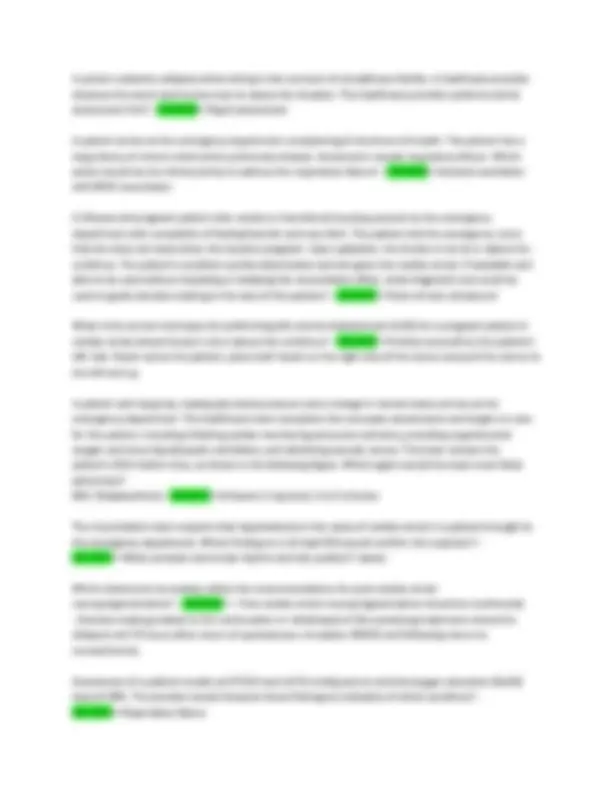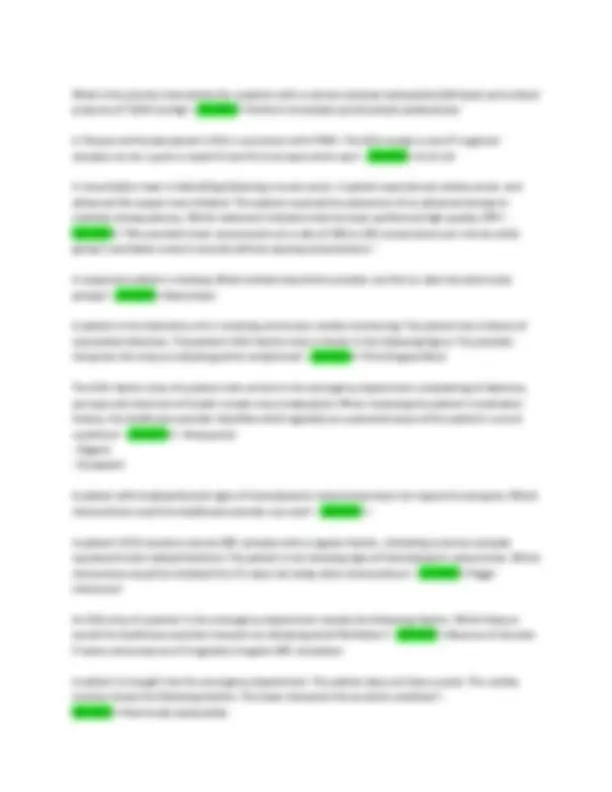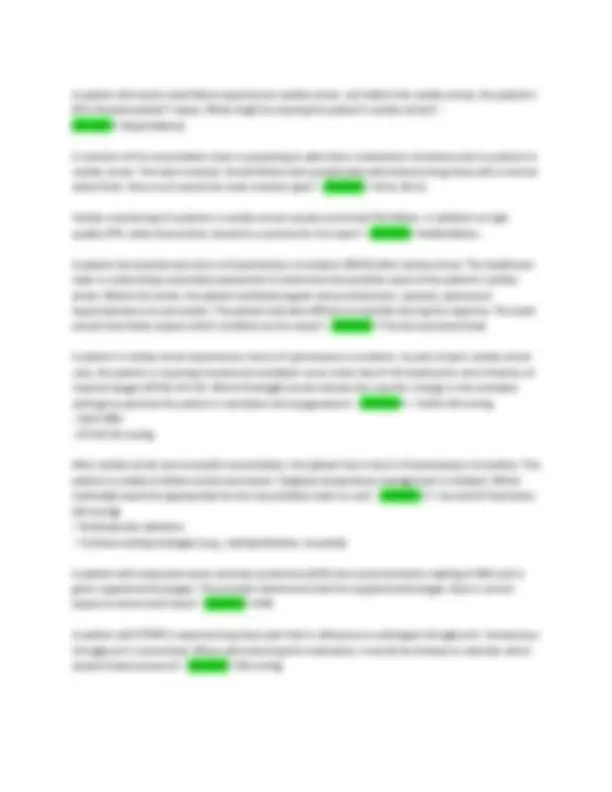





Study with the several resources on Docsity

Earn points by helping other students or get them with a premium plan


Prepare for your exams
Study with the several resources on Docsity

Earn points to download
Earn points by helping other students or get them with a premium plan
Community
Ask the community for help and clear up your study doubts
Discover the best universities in your country according to Docsity users
Free resources
Download our free guides on studying techniques, anxiety management strategies, and thesis advice from Docsity tutors
ACLS EXAM LATEST VERSION 2025 QUESTIONS AND ANSWERS
Typology: Exams
1 / 6

This page cannot be seen from the preview
Don't miss anything!




A 42-year-old woman presents to the emergency department with complaints of fatigue, shortness of breath, back pain and nausea. A 12-lead ECG is obtained and shows ST-segment depression in leads II, III, and aVF and intermittent runs of nonsustained ventricular tachycardia. Cardiac serum markers are elevated. These findings suggest which condition? - ANSWER>>High-risk non-ST-segment elevation ACS (NSTE-ACS)
A patient is being treated in the emergency department and is determined to have NSTE-ACS. Invasive management is planned based on which finding? - ANSWER>>Ventricular tachycardia
A patient experiences cardiac arrest, and the resuscitation team initiates ventilations using a bag-valve- mask (BVM) resuscitator. The development of which condition during the provision of care would lead the team to suspect that improper BVM technique is being used? - ANSWER>>Pneumothorax
A patient is admitted to the emergency department of a large medical center. The patient is diagnosed with STEMI. The facility is capable of administering PCI. To achieve the best outcomes, therapy should be administered to this patient within what time frame? - ANSWER>>Within 90 minutes of the patient's first medical contact
A patient is in cardiac arrest. The cardiac monitor shows asystole. In addition to providing continuous high-quality CPR, what is the other priority intervention for this patient? - ANSWER>>Administering epinephrine as early as possible
A patient is in cardiac arrest. The underlying cause is thought to be opioid toxicity. Which statement accurately describes the use of naloxone for this patient? - ANSWER>>Naloxone should be administered as soon as possible but is not a priority over high-quality CPR and AED use.
Which statement accurately reflects the management of cardiac arrest in a pregnancy of 26 weeks' gestation? - ANSWER>>Resuscitative cesarean delivery (RCD) should be performed within 5 minutes from the time of arrest.
Cardiac monitoring indicates that a patient has a ventricular tachyarrhythmia. The patient has a pulse and is not showing any signs of hemodynamic compromise. A 12-lead ECG reveals an irregular rhythm with QRS complexes greater than 0.12 second in duration. Which action would be appropriate at this time? - ANSWER>>Consider an antiarrhythmic medication
A 20-year-old man with respiratory depression is brought to the emergency department by his parents. Opioid overdose is suspected, and an initial dose of naloxone is administered at 10 p.m. The patient does not respond to this initial dose. The team would expect to administer a second dose after how many minutes? - ANSWER>>2 minutes
Assessment of a patient in the emergency department reveals that the patient is experiencing respiratory compromise. From the assessment, the team identifies that the patient is in the earliest stage of this condition. Which stage would this be? - ANSWER>>Respiratory distress
A patient is experiencing respiratory distress secondary to an exacerbation of chronic obstructive pulmonary disease. The patient begins to exhibit signs and symptoms of worsening respiratory function and experiences respiratory arrest. The team intervenes, delivering ventilations via BVM resuscitator. The team should provide ventilations at a rate of 1 ventilation: - ANSWER>>Every 6 seconds
A 30-year-old patient has been brought to the emergency department in cardiac arrest. The cardiac monitor shows the following rhythm. Interpretation of this rhythm would suggest which of the following as a possible precipitating factor
EKG: VFIB - ANSWER>>Electrocution
A patient enters the emergency department in respiratory compromise. The team is monitoring the patient using capnography and identifies that ETCO2 levels are initially 33 mmHg and later 40 mmHg. From these readings, the team identifies that the patient is progressing in what stage of respiratory compromise? - ANSWER>>Respiratory distress
A member of the resuscitation team is preparing to defibrillate a patient in cardiac arrest using a biphasic defibrillator. The team member would set the energy dose according to the manufacturer's recommendations, which is usually: - ANSWER>>120 to 200 joules
The following capnogram is from a patient experiencing respiratory distress. At which point in the waveform would the patient's ETCO2 level be measured? - ANSWER>>D
A patient comes to the emergency department complaining of palpitations and "some shortness of breath." Cardiac monitoring is initiated and reveals the following ECG rhythm strip. The provider interprets this strip as indicating which arrhythmia? - ANSWER>>Atrial Flutter
A patient is receiving ventilation support via bag-valve-mask (BVM) resuscitator. Capnography is established and a blood gas is obtained to evaluate the adequacy of the ventilations. Which arterial carbon dioxide (PaCO2) value signifies adequate ventilations? - ANSWER>>35 to 45 mmHg
What is the priority intervention for a patient with a narrow-complex tachycardia (160 bpm) and a blood pressure of 72/48 mmHg? - ANSWER>>Perform immediate synchronized cardioversion
A 35-year-old female patient's ECG is consistent with STEMI. The ECG reveals a new ST-segment elevation at the J point in leads V2 and V3 of at least which size? - ANSWER>>0.15 mV
A resuscitation team is debriefing following a recent event. A patient experienced cardiac arrest, and advanced life support was initiated. The patient required the placement of an advanced airway to maintain airway patency. Which statement indicates that the team performed high-quality CPR? - ANSWER>>"We provided chest compressions at a rate of 100 to 120 compressions per minute while giving 1 ventilation every 6 seconds without pausing compressions."
A responsive patient is choking. What method should the provider use first to clear the obstructed airway? - ANSWER>>Back blows
A patient in the telemetry unit is receiving continuous cardiac monitoring. The patient has a history of myocardial infarction. The patient's ECG rhythm strip is shown in the following figure. The provider interprets this strip as indicating which arrhythmia? - ANSWER>>Third Degree Block
The ECG rhythm strip of a patient who arrived in the emergency department complaining of dizziness, syncope and shortness of breath reveals sinus bradycardia. When reviewing the patient's medication history, the healthcare provider identifies which agent(s) as a potential cause of the patient's current condition? - ANSWER>>- Metoprolol
A patient with bradycardia and signs of hemodynamic compromise does not respond to atropine. Which interventions could the healthcare provider use next? - ANSWER>>
A patient's ECG reveals a narrow QRS complex with a regular rhythm, indicating a narrow-complex supraventricular tachyarrhythmia. The patient is not showing signs of hemodynamic compromise. Which intervention would be initiated first if it does not delay other interventions? - ANSWER>>Vagal maneuvers
An ECG strip of a patient in the emergency department reveals the following rhythm. Which feature would the healthcare provider interpret as indicating atrial fibrillation? - ANSWER>>Absence of discrete P waves and presence of irregularly irregular QRS complexes
A patient is brought into the emergency department. The patient does not have a pulse. The cardiac monitor shows the following rhythm. The team interprets this as which condition? - ANSWER>>Ventricular tachycardia
A patient with acute renal failure experiences cardiac arrest. Just before the cardiac arrest, the patient's ECG showed peaked T waves. What might be causing the patient's cardiac arrest? - ANSWER>>Hyperkalemia
A member of the resuscitation team is preparing to administer medications intravenously to a patient in cardiac arrest. The team member should follow each peripherally administered drug dose with a normal saline flush. How much would the team member give? - ANSWER>>10 to 20 mL
Cardiac monitoring of a patient in cardiac arrest reveals ventricular fibrillation. In addition to high- quality CPR, what intervention should be a priority for the team? - ANSWER>>Defibrillation.
A patient has experienced return of spontaneous circulation (ROSC) after cardiac arrest. The healthcare team is conducting a secondary assessment to determine the possible cause of the patient's cardiac arrest. Before the arrest, the patient exhibited jugular venous distension, cyanosis, apnea and hyperresonance on percussion. The patient was also difficult to ventilate during the response. The team would most likely suspect which condition as the cause? - ANSWER>>Tension pneumothorax
A patient in cardiac arrest experiences return of spontaneous circulation. As part of post-cardiac arrest care, the patient is receiving mechanical ventilation at an initial rate of 10 breaths/min and a fraction of inspired oxygen (FiO2) of 0.30. Which finding(s) would indicate the need for change in the ventilator settings to optimize the patient's ventilation and oxygenation? - ANSWER>>- PaCO2 48 mmHg
After cardiac arrest and successful resuscitation, the patient has a return of spontaneous circulation. The patient is unable to follow verbal commands. Targeted temperature management is initiated. Which method(s) would be appropriate for the resuscitation team to use? - ANSWER>>• Ice-cold IV fluid bolus (30 mL/kg)
A patient with suspected acute coronary syndromes (ACS) has a pulse oximetry reading of 86% and is given supplemental oxygen. The provider determines that the supplemental oxygen dose is correct based on which SaO2 level? - ANSWER>>93%
A patient with STEMI is experiencing chest pain that is refractory to sublingual nitroglycerin. Intravenous nitroglycerin is prescribed. When administering this medication, it would be titrated to maintain which systolic blood pressure? - ANSWER>>90 mmHg